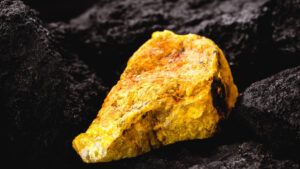Uranium veteran John Borshoff was excited last year, now he’s even more bullish

Pic: RichVintage/E+ via Getty Images
- U308 now trading at uS$56/lb, up from under US$20lb in 2016
- 60 new reactors under construction, 104 planned, 338 proposed
- China now becoming a major player
Now the boss of uranium hopeful Deep Yellow (ASX:DYL), which sees a pathway to developing its Tumas mine in Namibia by 2026, says his conviction in uranium’s bull case is even firmer.
Famously volatile spot prices have been among the few commodity indexes to have an air of stability this year.
Having languished as low as under US$20/lb — deep in lossmaking territory for most producers — when the former Paladin Energy (ASX:PDN) MD took the reins at DYL in 2016, U3O8 is now trading at US$56.25/lb.
And that’s just on spot. The main market, term contracting, is opaque to most on the margins of the industry. But Borshoff says that’s where green shoots are really starting to emerge.
“The market has tightened, although visibly you can’t see it because of the useless, bloody irrelevant declaration of spot and term by the (major price agencies) TradeTech and UxC,” he told Stockhead.
“This is not an LME, this is a chummy, this, this and that and a lot of the transactional stuff is going on behind the scenes.
“So when I spoke to you, the collared prices, the sort of floor-ceiling prices, were sort of sitting at about US$35-40/lb floor and about US$55 ceiling.
“And those contracts had also the optionality where they could screw the producer even more of a 20% option — 20% less or 20% more — and they could call on that a few months before the delivery.
“Now, they’re sort of sitting at US$50 floors, US$85 ceilings. So that’s another pressure point and the discounting has gone down to 5%. We believe they’re all trends that are coming through and haven’t even hit the high spots.”
What is driving this?
Behind the wheel is a situation where the nuclear reactor fleet worldwide has an ambitious growth profile.
As of April this year the World Nuclear Association estimated there were 60 new reactors under construction and 104 planned, with 338 proposed at the more blue sky end of the construction forecasts.
“I’m firming up on this (uranium bull case) even more, because what’s happening is it’s not only the sort of issue of the producer and the utility that are now the partners forever fuelling that existing fleet,” Borshoff said last month.
“With this huge demand of building new reactors, all of a sudden you’ve got a new requirer of product, which is the Westinghouses, the bloody GEs because they will never sign up a contract without the first fill uranium.
“And those 200-300 reactors are going to be built are going to hit the demand requirements early because before they sign up, they have to have that assurance.
“And even though that reactor won’t go into service in up to six to eight years time, that wasn’t apparent at the time 12 months ago.”
Even bigger may be the ambitious growth targets of China, the world’s biggest emitter, which wants to hit Net Zero by 2060 and views a massive expansion of nuclear power as a means to that end.
“So I see that late this year, early during next year, there’ll be a breakout, that has to be because you can’t have China declaring 400GW of installed nuclear power by 2060 — and it’s real, by the way — I know, I’m talking to that level of people over there,” Borshoff mused.
“They need to be building 10-15 reactors a year out to 2050-2060. And the interesting part is the nuclear today of China, with their 55 reactors, from bloody zero in two-double ‘O’-four is about 4-5%.
“When they get to that level they’re aiming for it will only be 18% and nuclear operates the best between 20-30% share of that market. The Chinese are going to hoover material to support their build programs.
“So the Chinese there have got their builders and they’ve got their operators. The operators need fuel for what they’re burning every year in the units, the builders need to fulfill their obligation contractually that they supply a fully loaded (plant).
“So that’s just that side and I believe there will be as many reactors built outside of China. Now the 400GW is what the world today is in a nuclear fleet. They’re going to replicate that, that’s China alone.”
Where do prices need to go?
Borshoff has been an outspoken critic of companies contracting too early, believing stronger prices providing more robust economic outcomes for producers are still on their way.
“We’re not signing contracting, the price is now within US$7 of our target. And we will we will hold off. We are saying minimum US$65. It might consolidate out at US$75 or whatever it might be,” he said.
“So we’ve got to look at for our shareholders, for the sake of sort of two-three months, and not lock our shareholders out of opportunity.
“Because our sort of goal, we don’t get any sort of excitement saying, ‘Oh, we’re the first guy that’s going to run down the bottom by being the first producer rushing at these bloody contracts’.”
A DFS this year put a US$372 million price tag on building the Namibian Tumas asset, which would produce 3.6Mlb of uranium oxide and 1.15Mlb of vanadium pentoxide a year.
Beyond that DYL picked up, via its acquisition last year of Vimy Resources, the Mulga Rock project in WA, one of just four to receive State Environmental Approval before the anti-uranium WA Labor Government came into power in 2017.
In more established uranium jurisdictions in Namibia, South Australia and Wyoming, USA, three ASX players have already made moves to restart idled operations in Paladin’s Langer Heinrich, Boss Energy’s (ASX:BOE) Honeymoon and Peninsula Energy’s (ASX:PEN) Lance ISR project, though the latter had stalled after a nearby producer canned a plan to toll treat material from its project.
Further down the line, explorers are operating in a more promising environment than they have for years.
The rehabilitation of the nuclear sector’s image as a low emissions power source and solution amid a drive to replace carbon-emitting fossil fuels as baseload energy has many uranium executives confident they will see improved demand in the years to come.
“We’re extremely optimistic. We’re seeing the decarbonisation-electrification theme pushed very hard and we know that if those two are going to be achieved, we need low carbon emission energy being produced,” Elevate Uranium (ASX:EL8) MD Murray Hill said.
“And nuclear is that and also we need reliable energy. We’ve heard recently they’re doubling the amount of pull on the grid by just putting a few cars, electric vehicles plugged into it. So that energy has got to come from somewhere.
“So we need reliable baseload energy, and that’s what nuclear is. So I’m very, very bullish that if the world keeps going down the path it’s going, we have to have nuclear — full stop.”
Exploration successes emerging
Like Deep Yellow, Elevate is exploring in Namibia, where foreign companies expelled a sigh of relief after fears the government could take larger stakes in existing mining leases were recently allayed.
Hill said they had been strongly supported by investors in a stronger uranium price environment and with recent exploration success at the Koppies project, where Elevate has so far outlined an inferred resource containing around 20Mlb of U3O8.
He said there was no specific incentive price, but that it remained well supported to drill. Elevate had around $10 million in the bank as of June 30.
“We don’t want to get ahead of ourselves, we want to make sure that we’re exploring successfully, and as the uranium price starts to move, then we’ll start to look at which projects we want to put into production first, and what the cost might be for that to occur,” Hill said.
“We’re successfully exploring, we’ve had four discoveries in the last four years. So we’ve had a bit of funding come our way because of that success and that continues.
“We’ve put four geos on in the last four months in Namibia and we’ve got three drill rigs working. I think at the end of the day, exploration’s achieving something, so that attracts some investors.”

UNLOCK INSIGHTS
Discover the untold stories of emerging ASX stocks.
Daily news and expert analysis, it's free to subscribe.
By proceeding, you confirm you understand that we handle personal information in accordance with our Privacy Policy.








